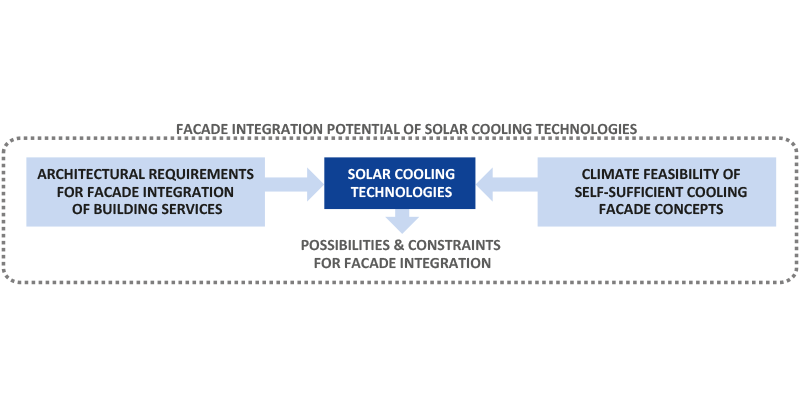Downloads
DOI:
https://doi.org/10.7480/jfde.2018.3.2468Keywords:
solar cooling, facade design, integrated facades, renewables, barriersAbstract
Cooling demands in buildings have drastically increased in the last decades and will follow that trend in the near future, due to increasing standards of life and global climate change among the most relevant factors. Besides energy consumption, the use of refrigerants in common vapor compression cooling technologies is a source of concern for their environmental impact. Hence, there is a need to decrease cooling demands in buildings while looking for alternative clean technologies to take over the remaining loads. Solar cooling systems have gained increased attention these last years, for its potential to lower indoor temperatures using renewable energy, under environmentally friendly cooling processes. Nonetheless, their potential for building integration has not been fully explored, with the exemption of scattered prototypes and concepts. This paper aims to address these knowledge gaps by presenting the results of the PhD research project ‘COOLFACADE: Architectural integration of solar technologies in the building envelope’. The research project explored the possibilities and constraints for architectural integration of solar cooling strategies in façades, in order to support the design of climate responsive architectural products for office buildings, driven by renewable energy sources. The paper explores different aspects related to façade integration and solar cooling technologies, in order to provide a comprehensive understanding of current possibilities for façade integration; while drafting recommendations based on identified barriers and bottlenecks at different levels.
How to Cite
Published
Issue
Section
License
Copyright (c) 2018 Alejandro Prieto, Ulrich Knaack, Tillmann Klein, Thomas Auer

This work is licensed under a Creative Commons Attribution 4.0 International License.
Authors or their institutions retain copyright to their publications without restrictions.
References
Avesani, S. (2016). Design of a solar façade solution with an integrated sorption collector for the systemic retrofit of the existing office buildings. (Doctoral thesis), Leopold-Franzens-Universität Innsbruck, Innsbruck, Austria.
Balaras, C. A., Grossman, G., Henning, H.-M., Infante Ferreira, C. A., Podesser, E., Wang, L., & Wiemken, E. (2007). Solar air conditioning in Europe—an overview. Renewable and Sustainable Energy Reviews, 11(2), 299-314. doi: 10.1016/j.rser.2005.02.003
BP. (2016). BP Energy Outlook, 2016 edition. London, United Kingdom.
DOE/EIA. (2016). International Energy Outlook 2016. Washington, DC, USA: US Energy Information Administration, US Department of Energy.
Finocchiaro, P., Beccali, M., Brano, V. L., & Gentile, V. (2016). Monitoring Results and Energy Performances Evaluation of Freescoo Solar DEC Systems. Energy Procedia, 91, 752-758. doi: 10.1016/j.egypro.2016.06.240
Goetzler, W., Zogg, R., Young, J., & Johnson, C. (2014). Energy savings potential and RD&D opportunities for non-vapor-compression HVAC technologies. USA: U.S. Department of Energy, Office of Energy Efficiency and Renewable Energy, Building Technologies Office.
Henning, H.-M. (2007). Solar assisted air conditioning of buildings – an overview. Applied Thermal Engineering, 27(10), 1734-1749. doi: http://dx.doi.org/10.1016/j.applthermaleng.2006.07.021
Henning, H.-M., & Döll, J. (2012). Solar Systems for Heating and Cooling of Buildings. Energy Procedia, 30, 633-653. doi: 10.1016/j.egypro.2012.11.073
Ibañez-Puy, M., Martín-Gómez, C., Bermejo-Busto, J., Sacristán, J. A., & Ibañez-Puy, E. (2018). Ventilated Active Thermoelectric Envelope (VATE): Analysis of its energy performance when integrated in a building. Energy and Buildings, 158, 1586-1592. doi: 10.1016/j.enbuild.2017.11.037
Jochem, E., & Schade, W. (2009). 2-degree scenario for Europe - policies and impacts. ADAM: Adaptation and mitigation strategies: supporting European climate policy. Karlsruhe: Fraunhofer Institute for Systems and Innovation Research (Fraunhofer-ISI).
Montagnino, F. M. (2017). Solar cooling technologies. Design, application and performance of existing projects. Solar Energy. doi: 10.1016/j.solener.2017.01.033
OECD/IEA. (2015). Energy and climate change / World Energy Outlook Special Report. Paris, France: IEA - International Energy Agency.
Prieto, A., Klein, T., Knaack, U., & Auer, T. (2017). Main perceived barriers for the development of building service integrated facades: Results from an exploratory expert survey. Journal of Building Engineering, 13, 96-106. doi: 10.1016/j.jobe.2017.07.008
Prieto, A., Knaack, U., Auer, T., & Klein, T. (2017a). SOLAR COOLFACADES Framework for the integration of solar cooling technologies in the building envelope. Energy. doi: https://doi.org/10.1016/j.energy.2017.04.141
Prieto, A., Knaack, U., Auer, T., & Klein, T. (2017b). Solar façades – Main barriers for widespread façade integration of solar technologies. Journal of Facade Design and Engineering, 5(1), 51-62. doi: 10.7480/jfde.2017.1.1398
Prieto, A., Knaack, U., Auer, T., & Klein, T. (2018). Feasibility Study of Self-Sufficient Solar Cooling Façade Applications in Different Warm Regions. Energies, 11(6), 1475. doi: 10.3390/en11061475
Prieto, A., Knaack, U., Klein, T., & Auer, T. (2018). Passive cooling & climate responsive facade design - Exploring the limits of passive cooling strategies to improve the performance of commercial buildings in warm climates. Energy and Buildings, (accepted for publication).
Qi, C. (2006). Office Building Energy Saving Potential in Singapore. (MSc Thesis), National University of Singapore (NUS), Singapore.
Santamouris, M. (2016). Cooling the buildings – past, present and future. Energy and Buildings, 128, 617-638. doi: 10.1016/j.enbuild.2016.07.034
SolarInvent. (n.d.). Freescoo / SolarInvent S.r.l. - http://www.freescoo.com. (accesed on April 11th 2018).
Xu, X., & Van Dessel, S. (2008). Evaluation of an Active Building Envelope window-system. Building and Environment, 43(11), 1785-1791. doi: 10.1016/j.buildenv.2007.10.013
